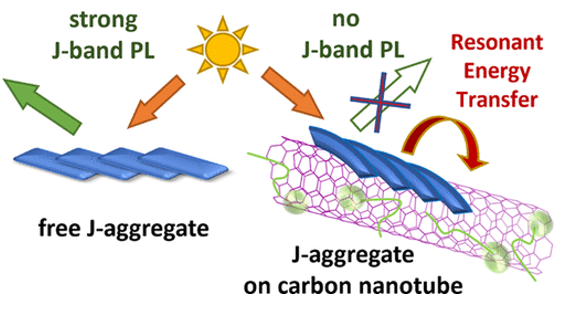Self-Assembly for Two Types of J-Aggregates: cis-Isomers of Dye on the Carbon Nanotube Surface and Free Aggregates of Dye trans-Isomers
Development of novel nanoscale devices requires unique functional nanomaterials. Furthermore, chemical design of different nanoparticles in one unit is a complex task, particularly the application of self-assembly J-aggregates, which can substantially advance the nanomaterial’s properties due to resonant delocalization of excitons.
In this paper, the first time formation of resonantly coherent J-aggregates on carbon nanotubes is demonstrated, with highly efficient energy transfer from the aggregates to the nanotubes. All the energy of photons absorbed by the aggregates is conveyed to the nanotubes, completely quenching the J-band emission and photosensitizing the nanotubes. Overall, the formation of two types of J-aggregates is discovered, where one type is related to self-assembly of cis-isomers on the nanotube surface and the second type is associated to self-organizing trans-isomers into free J-aggregates without the nanotubes.
Importantly, the J-aggregates on carbon nanotubes with strong energy transfer peaks of photoluminescence in the near infrared range are of high interest for practical applications on biomedical imaging and nanoscale optoelectronic and nanophotonic devices.
View the full article on ACS Publications.
Keep up to date
To be the first to hear about the latest research, news and products from Edinburgh Instruments, why not join us on social media and sign up to our eNewsletter today.









